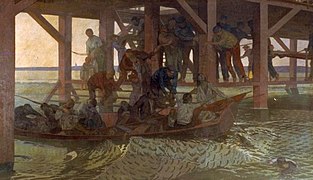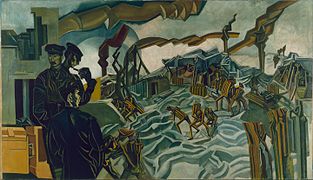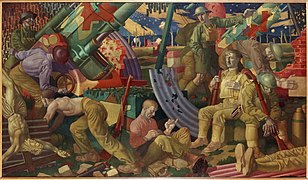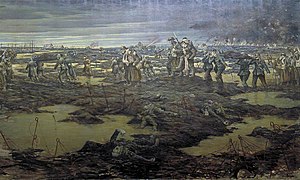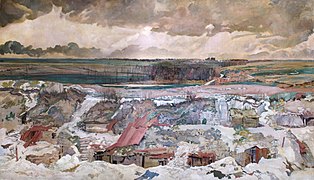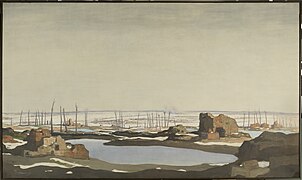
Vorticism was a London-based modernist art movement formed in 1914 by the writer and artist Wyndham Lewis. The movement was partially inspired by Cubism and was introduced to the public by means of the publication of the Vorticist manifesto in Blast magazine. Familiar forms of representational art were rejected in favour of a geometric style that tended towards a hard-edged abstraction. Lewis proved unable to harness the talents of his disparate group of avant-garde artists; however, for a brief period Vorticism proved to be an exciting intervention and an artistic riposte to Marinetti's Futurism and the post-impressionism of Roger Fry's Omega Workshops.

Imperial War Museums (IWM), is a British national museum. It is headquartered in London, with five branches in England. Founded as the Imperial War Museum in 1917, it was intended to record the civil and military war effort and sacrifice of the United Kingdom and its Empire during the First World War. The museum's remit has since expanded to include all conflicts in which British or Commonwealth forces have been involved since 1914. As of 2012, the museum aims "to provide for, and to encourage, the study and understanding of the history of modern war and 'wartime experience'."
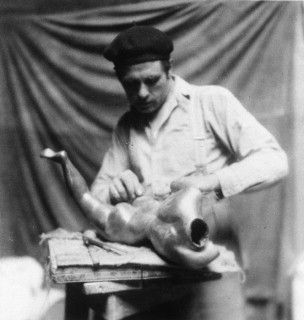
George Claude Leon Underwood was a British artist, although primarily known as a sculptor, printmaker and painter, he was also an influential teacher and promotor of African art. His travels in Mexico and West Africa had a substantial influence on his art, particularly on the representation of the human figure in his sculptures and paintings. Underwood is best known for his sculptures cast in bronze, carvings in marble, stone and wood and his drawings. His lifetime's work includes a wide range of media and activities, with an expressive and technical mastery. Underwood did not hold modernism and abstraction in art in high regard and this led to critics often ignoring his work until the 1960s when he came to be viewed as an important figure in the development of modern sculpture in Britain.

Christopher Richard Wynne Nevinson was an English figure and landscape painter, etcher and lithographer, who was one of the most famous war artists of World War I. He is often referred to by his initials C. R. W. Nevinson, and was also known as Richard.

Paul Nash was a British surrealist painter and war artist, as well as a photographer, writer and designer of applied art. Nash was among the most important landscape artists of the first half of the twentieth century. He played a key role in the development of Modernism in English art.

Dazzle camouflage, also known as razzle dazzle or dazzle painting, is a family of ship camouflage that was used extensively in World War I, and to a lesser extent in World War II and afterwards. Credited to the British marine artist Norman Wilkinson, though with a rejected prior claim by the zoologist John Graham Kerr, it consisted of complex patterns of geometric shapes in contrasting colours interrupting and intersecting each other.

Edward Alexander Wadsworth was a British artist initially associated with the Vorticism movement. In the First World War he was part of a team involved in the transfer of dazzle camouflage designs to ships for the Royal Navy. After the war his maritime landscapes and still-life compositions using tempera were infused with a surrealistic mood - although he never exhibited with the British surrealists. In the early thirties and in the early forties his work was mainly abstract. He made a significant contribution to the development of modern art in Britain in the inter-war years.
Events from the year 1918 in art.

Norman Wilkinson was a British artist who usually worked in oils, watercolours and drypoint. He was primarily a marine painter, but also an illustrator, poster artist, and wartime camoufleur. Wilkinson invented dazzle painting to protect merchant shipping during the First World War.

The First World War, which was fought between 1914 and 1918, had an immediate impact on popular culture. In the over a hundred years since the war ended, the war has resulted in many artistic and cultural works from all sides and nations that participated in the war. This included artworks, books, poems, films, television, music, and more recently, video games. Many of these pieces were created by soldiers who took part in the war.

Gassed is a very large oil painting completed in March 1919 by John Singer Sargent. It depicts the aftermath of a mustard gas attack during the First World War, with a line of wounded soldiers walking towards a dressing station. Sargent was commissioned by the British War Memorials Committee to document the war and visited the Western Front in July 1918 spending time with the Guards Division near Arras, and then with the American Expeditionary Forces near Ypres. The painting was finished in March 1919 and voted picture of the year by the Royal Academy of Arts in 1919. It is now held by the Imperial War Museum. It visited the US in 1999 for a series of retrospective exhibitions, and then from 2016 to 2018 for exhibitions commemorating the centenary of the First World War.
British official war artists were a select group of artists who were employed on contract, or commissioned to produce specific works during the First World War, the Second World War and select military actions in the post-war period. Official war artists have been appointed by governments for information or propaganda purposes and to record events on the battlefield; but there are many other types of war artist.

The Capture of Oppy Wood was an engagement on the Western Front during the First World War on 28 June 1917. The Battle of Arras of 1917 ended with the Germans in possession of a fortified wood to the west of the village of Oppy, which overlooked British positions. The wood was 1 acre (0.4 ha) in area and contained many German observation posts, machine-gun nests and trench mortars. New German defensive tactics adopted after the Battle of the Somme of defence in depth and rapid counter-attack, had been enforced on the German 6th Army after the disaster of 9 April, the first day of the Battle of Arras. The British attack of the Third Battle of the Scarpe (3–4 May), was defeated everywhere bar Fresnoy, which was captured by the 1st Canadian Division. The attack on Oppy Wood by the 92nd Brigade of the 31st Division, was a costly failure. The area was defended by the 1st Guard Reserve Division and the 15th Reserve Division, which did not need the support of specialist Eingreif (counter-attack) divisions.
Joseph Gray was a Durham-born painter and etcher of landscapes, architectural subjects and battlefield scenes. Some of his most evocative work hangs in the Imperial War Museum and different Regimental Museums throughout Britain.
Walter John Bayes was an English painter and illustrator who was a founder member of both the Camden Town Group and the London Group and also a renowned art teacher and critic.
Colin Unwin Gill was an English artist who painted murals and portraits and is most notable for the work he produced as a war artist during the First World War.

Darsie Napier Japp MC was an English painter and soldier.
The British War Memorials Committee was a British Government body that throughout 1918 was responsible for the commissioning of artworks to create a memorial to the First World War. The Committee was formed in February 1918 when the Department of Information, which had been responsible for war-time propaganda and also operated a war artists scheme, became the Ministry of Information with Lord Beaverbrook as its Minister. Beaverbrook had been running, from London, the Canadian Government's scheme to commission contemporary art during the First World War and believed Britain would benefit from a similar project. Beaverbrook wanted the British War Memorials Committee to change the direction of Government-sponsored art away from propaganda of short-term value only during the conflict to a collection with a much longer lasting national value. Arnold Bennett, alongside Beaverbrook, was the driving force behind the BWMC and was instrumental in ensuring young artists, including those seen as modernist or avant-garde, were commissioned by the Committee over older British artists, many of whom were associated with the Royal Academy.
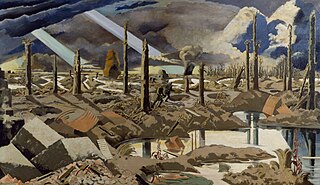
The Menin Road is a large oil painting by Paul Nash completed in 1919 that depicts a First World War battlefield. Nash was commissioned by the British War Memorials Committee to paint a battlefield scene for the proposed national Hall of Remembrance. The painting is considered one of the most iconic images of the First World War and is held by the Imperial War Museum.
John Laviers Wheatley was a British painter, art teacher and museum director who also served as a war artist in both World War I and in World War II.





